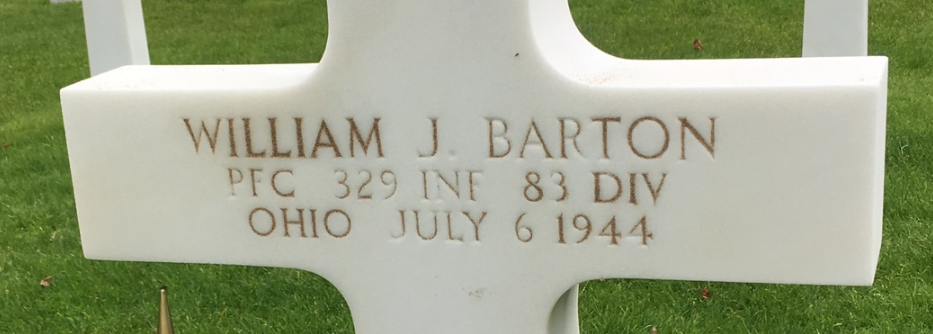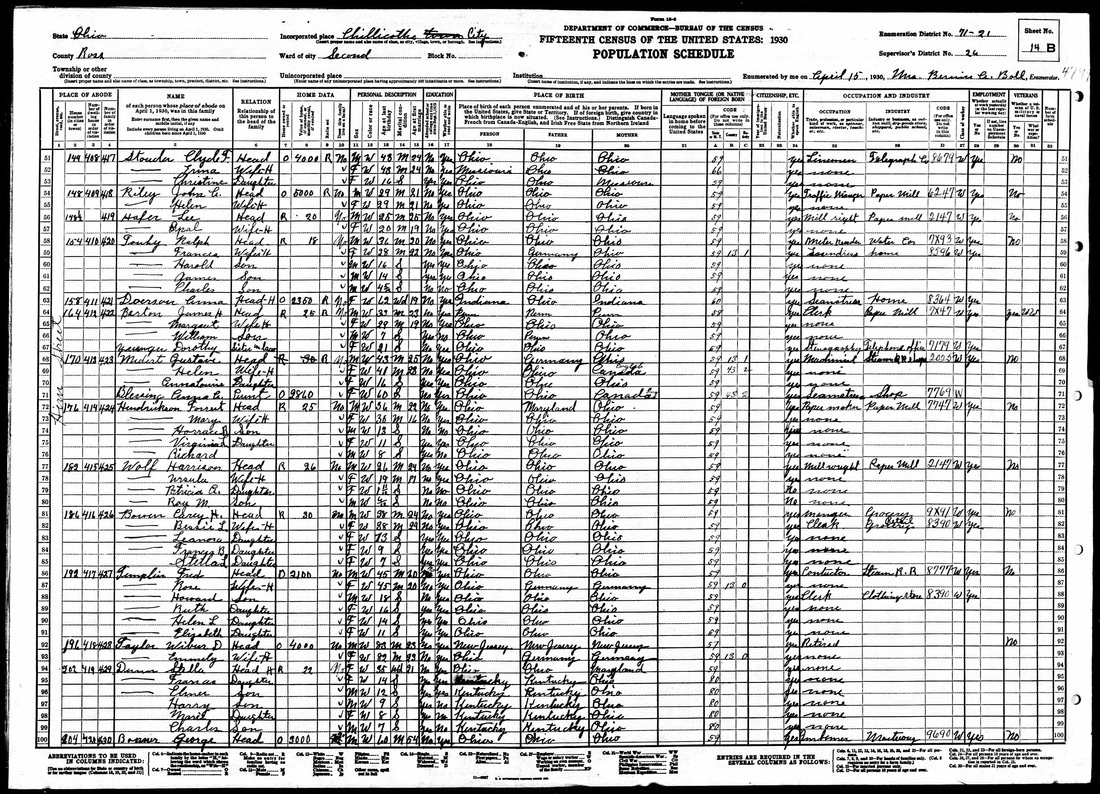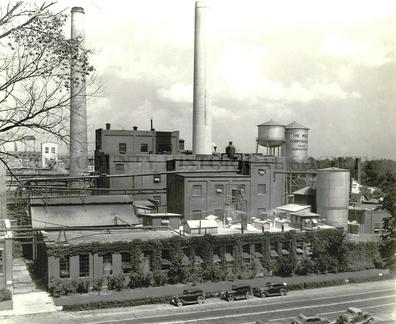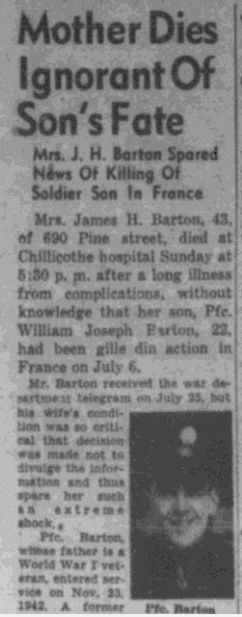Private First Class William J. Barton

- Unit: 83rd Infantry Division, 329th Infantry Regiment
- Service Number: 35613296
- Date of Birth: November 30, 1921
- Entered the Military: November 9, 1942
- Date of Death: July 6, 1944
- Hometown: Chillicothe, Ohio
- Place of Death: Normandy, France
- Award(s): Purple Heart
- Cemetery: Plot C, Row 14, Grave 10. Normandy American Cemetery, Colleville-sur-Mer, France
Mentored by Ms. Mary Bezbatchenko
Licking Heights High School
2015-2016
Early Life
William James Barton was born in 1922, the only son of James and Margaret Barton. According to city directories, James worked as a salesman in 1928 while the family lived at 192 Hirn Street. In the 1930 census, Williams’s aunt, Dorothy, also lived with the family. At one point, William worked as a newspaper carrier for the local paper.
In the 1940 census, William is listed living with his grandfather, William Yuenger. By 1942, William’s parents moved to Knowles Avenue and his father worked as a paper maker, most likely at the Mead Company that was located at the end of the street.
Barton was a graduate of Chillicothe High School, but he was not pictured in the senior yearbook.



Homefront
Chillicothe
Once the capital of Ohio, Chillicothe sits on the Scioto River in southern Ohio. During the first World War, it was the site of Camp Sherman, a military training camp that more than tripled the population of the city. Soon after the war, the population drastically decreased , though its paper industry which drove its economy continued to prosper. The first paper mills in the town were established in 1847, the most successful being the Mead Pulp and Paper Company.
Defense
For the first time in military history, America engaged with enemies that had the ability to easily attack inland, thanks to air power. Chillicothe quickly applied defense precautions and established organizations to mandate them. Edgar Hess, director of the Civilian Defense for Chillicothe,managed air raid wardens, police and fire rescue, and road repair as well as supervised the group responsible for finding emergency food and housing. The organization was entirely dependent on volunteers and often lacked the federally recommended number (1,100) of volunteers for a city of 20,000 people during the war.
Due to its industrial factories and large work force, Ohio was considered a likely air raid target.Wardens were assigned to patrol the city, enforcing nightly curfews and blackout procedures. To signal an air raid, all of the city’s major industrial whistles (like those at the Mead Paper Company) were to be blown simultaneously. The Red Cross instructed the citizens of Chillicothe on how to properly care for the wounded.
Rationing
Chillicothe’s economy rapidly transitioned to the new reality of wartime conservation. A history of the city revealed that the city had nearly all rationing regulations in place by the end of January 1942. Tires became the first rationed good in Chilicote. Citizens were encouraged to walk or take the bus to conserve scarce rubber.
The city’s Office of Price Administration (OPA) started limiting food items for the war effort as well. Sugar became the first food to be included on rationing lists. Other essential goods such as meats, coffee, and canned goods were added as well. The OPA not only set regulations on the amount of goods citizens could purchase, but also the prices, which could not exceed those set in place by the federal government.
Curtiss-Wright Corporation
Prior to being drafted into the military, William James Barton worked at Curtiss-Wright, an aerospace company in Columbus, The company was the largest aircraft producer ofWorld War II, creating 13,738 of their famous P-40 WarHawks? throughout the course of the war. The company noted its wartime production included “142,840 aircraft engines; 146,468 electric propellers; 29,269 airplanes which included the Curtiss Commando transport and the Navy dive bomber, the Helldiver.”


Military Experience
Barton was drafted into the 83rd Infantry Division, 329th Infantry Regiment, on November 23, 1942.
Camp Atterbury and Camp Breckinridge
The 83rd Infantry Division trained at Camp Atterbury, Indiana (commissioned January 6, 1941). It was created to house 30,000 soldiers that were preparing for war. The division was led by Major General Frank W. Milburn. Training at Atterbury consisted of marches, rifle training, bayonet courses, exercises in all types of weather, and field inspections. At the end of a grueling 13 weeks (though the men were given furloughs and weekend passes to Indianapolis), the soldiers of the 83rd Infantry Division proceeded on to Camp Breckinridge, Kentucky.
Before heading to Breckinridge, however, the division made a brief stop in Tennessee. They trained for maneuvers with the 80th Infantry Division and the 101st Airborne Division. They made day long marches in the heat with only one canteen of water. The training was designed to simulate how fighting in Europe would be. Divisions practiced assaults, defense, digging foxholes, and combat with blank ammunition. On August 8, 1943, it was announced that they would be going to Kentucky.
After arriving in Kentucky, the 83rd Infantry Divisionmade an exhausting 100-mile march from Springfield to Camp Breckinridge, which took five days. Until February the 329th Infantry Regiment underwent specialized training, eventually leaving for New York on March 24, 1944, where they would depart to England
Training for D-Day in England
On April 18, 1944, the 329th Infantry Regiment arrived in Liverpool, England, after 12 days aboard the HMS Samaria. The soldiers spent months marching through the mountains of northern Wales, sleeping outside on the damp ground under wool blankets. After training, the 329th Infantry Regiment moved to Wrexham, and then on to England’s southern shore along the English Channel.
Fighting in France
On the afternoon of June 23, the 329th Infantry Regiment landed on France’s Normandy coast at Omaha Beach. They made their way through the previously liberated city of Carentan to relieve the 101st Airborne Division.
Combat in the Hedgerows
The Norman hedgerows – also known as the “bocage” – have existed in the region since the twelfth century, as a way to mark property boundaries. Each hedge was generally between two and six feet wide at its base, and anywhere from three to 15 feet high. Atop the earthen base was a thicket of brambles, trees, and shrubs that created a “formidable barrier.” Throughout the Middle Ages, the individual plots of land grew smaller.
By 1944, the plots of land enclosed by hedgerows had been reduced to an average size of 50 to 100 yards between each hedgerow, making large-scale battles impossible to coordinate. With a lack of massive assaults, fighting in the hedgerows was reserved to skirmishes dependent entirely on teamwork. Prior to departing for D-day, soldiers in North Wales were given almost no training for hedgerow combat, which caused confusion and frustration; they quickly adapted. The fighting was broken into platoon by platoon, squad by squad skirmishes against a formidable German defense, which the terrain favored greatly. To clear a hedgerow, soldiers required the support of tanks; charges would be placed a few feet apart from one another and a tank equipped with a “rhinoceros” would clear away the debris, of course, this could only proceed when the fighting ceased.
The 329th Infantry Regiment in the Hedgerows
The Unit Journal for July 4 through 6 reports gruesome fighting. Heavy casualties were reported the morning of July 4. Officers reported that the “going was rough.” The men in the hedgerows were in desperate need of artillery. Later that morning, 30 men were evacuated and 35 were wounded after just two hours of fighting. After two days of similar situations, the 83rd Infantry Division gained just 200 yards of territory, captured six Germans, and had 1,400 casualties. Barton was sent to the hospital on July 5, and died one day later.

Eulogy
Names such as Eisenhower, Roosevelt, Patton, and Churchill will ring sonorously and be met with lauding so long as freedom and heroism are valued. However, the true heroism and sacrifice lies in the infinite multitudes of unknown faces and names carved into these graves and elsewhere. True courage rests in those whose seemingly small acts of bravery contribute collectively to overcome the greatest trials and tribulations of human existence: war. Researching these brave men who fought in the Normandy campaign have allowed us to see beyond the statistics and truly grasp the tragedy of their deaths.
Private First Class Barton and others like him are so much more than statistics and worthy of the many accolades bestowed upon them. We must not forget that they too, were human, many not much older than you or me, who sacrificed their lives for the most marvelous of human achievements: liberty. If we learn to cherish and praise these heroic individuals who paid the ultimate sacrifice for freedom, they will become revered in history as courageous soldiers and individuals, not just statistics.

Reflection
The Normandy: Sacrifice for Freedom Institute dramatically altered my perception and my appreciation of the men and women who sacrificed for our country and our freedom. Not only that, but my appreciation for those who they fought to protect, who have inherited the Earth, has grown immensely. On the trip, my faith was restored despite what I see as trying times. Often the past is forgotten, disregarded, or even totally, consciously unappreciated, despite its being fundamental to the civilization which we live. But, in spite of all modern contempt for history, I have been reminded, through the brilliant, passionate, and often hilarious people I met and feel like I have known for years.
The single most profound event (outside of delivering my eulogy) was walking on the cliffs of Omaha Beach and staring out at the infinitely expanding coastline and taking in the beauty and magical tranquility of the place. I could not help but feel a poignancy in the air, however. It was like a vague feeling of grief, comparable to that of returning to a loved place from childhood, and seeing that it is in some way altered; a swing set has been torn down, weeds have overgrown the flowers, a creepy, all too non-tranquil McDonald’s and a parking lot stand in the place of a field. I knew precisely what I was feeling; I truly (in all its banal glory) felt history come alive. I saw the courageous and anxious faces of young men. In no way can I equate my feeling to that of those soldiers some 70 years ago, but I had a glimpse, a faint one, but a glimpse nonetheless, on top of the cliffs of Omaha, staring down at the frivolously running, swimming, and exploring beach-goers, almost hating them for taking such hallowed ground so lightly. I quickly realized that the frivolity and lighthearted carelessness that freedom brings was exactly what those men were fighting for on D-Day.
Bibliography
Primary Sources
The Arrow. Students of Chillicothe High School (ed.), Chillicothe, Ohio: Chillicothe High School, 1939.
The Arrow. Students of Chillicothe High School (ed.), Chillicothe, Ohio: Chillicothe High School, 1940.
Chillicothe City Directory, 1928. Columbus, Ohio: R.L. Polk & Co., 1929.
Chillicothe City Directory, 1942. Columbus, Ohio: R.L. Polk & Co., 1942.
Chillicothe, Ohio 1796 – 1996. Chillicothe, Ohio: Ohio Bicentennial Commission, 1996.
Franklin County Council of Defense. October 1943. Franklin County Council of Defense (Ohio) Records. VFM 3082, Ohio History Connection, Columbus, Ohio.
Goguen, Raymond J., 329 “Buckshot” Infantry Regiment: a history, Record Group 407 (Box 10554); National Archives at College Park, College Park, MD.
“It’s Teamwork That Does It,” Chillicothe Gazette, June 6, 1944.
“Let These Guys Start It,” Chillicothe Gazette, August 2, 1944.
The Mead Corporation. Photograph. 1930s. Ross County Historical Society. rosscountyhistoricalsociety.tumblr.com/post/131494228602/the-mead-corporation-as-it-looked-in-the
Morning Report for 329th Infantry Regiment, July 6, 1944. 83rd Infantry Division Documents. Accessed March 12, 2016. 83rdinfdivdocs.org/.
“Mother Dies Ignorant of Son’s Fate,” Chillicothe Gazette, August 7, 1944.
Ohio. Ross County. 1930 U.S. Census. Digital Images. ancestry.com.
Ohio. Ross County. 1940 U.S. Census. Digital Images. ancestry.com.
Ohio War History Commission. Scrapbook of the American Red Cross in Ohio, 1942-1946 State Archives Series 2954, Ohio History Connection, Columbus, Ohio.
Ohio War History Commission. United States. Office of Price Administration. United States Office of Price Administration, World War II rationing stamps and forms, [ca. 1941-1945]. State Archives Series 2804, Ohio History Connection, Columbus, Ohio.
“Quality is Not Rationed Here,” Chillicothe Gazette, May 4, 1944.
Unit Journal for 329th Infantry Regiment, July 1944. 83rd Infantry Division Documents. Accessed March 12, 2016. 83rdinfdivdocs.org/.
“War Declared by Congress” Chillicothe Gazette, December, 1941.
William J. Barton. U.S. WWII Draft Cards Young Men, 1940-1947. ancestry.com.
William J. Barton. World War II Army Enlistment Records, 1938-1946. ancestry.com.
Secondary Sources
Medert, Pat, Stories From Chillicothe’s Past. 1998.
“Over 90 Years of Growth.” Curtiss Wright Corporation. Accessed May 9, 2020. www.curtisswright.com/company/history/.
West, James, “Camp Atterbury” Indiana Military. Last modified 2016. Accessed July 25, 2016. www.indianamilitary.org/Camp%20Atterbury/SoThinkMenu/CampAtterburySTART.htm.
“William J. Barton.” American Battle Monuments Commission. Accessed May 9, 2020. abmc.gov/decedent-search/barton%3Dwilliam.

